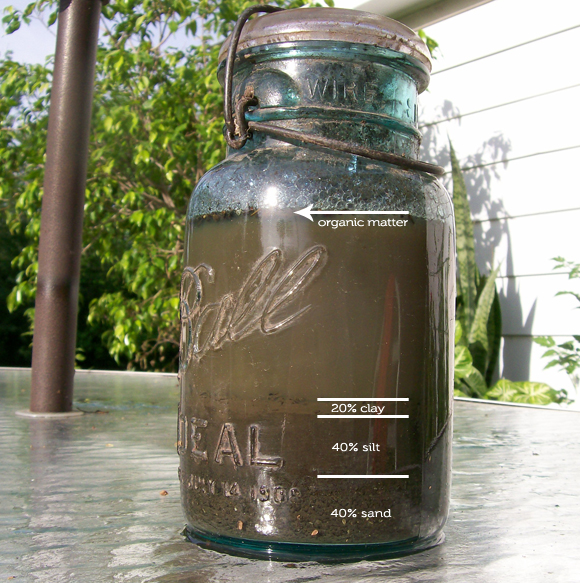Three Easy DIY Soil Tests
Great gardening starts with good soil right? and things grow differently in each type of soil. Different types of soil include sand, clay and silt. I tried the ‘jar test’ to determine what my garden soil is made of. It was easy and fun, a project your kids will love!
The Jar Test
I found this test in a few places each with different instructions, but the premise was the same. Find a mason jar. Add soil, water and dish soap. (The best combination for a large jar was 1 cup of soil, 1-2 cups of water and 1/2 tsp of dish soap) Shake it up for a minute to break everything up, and then let it sit. The soil will settle into layers.
Set the jar where it wont be disturbed, and in 24 hours all the layers should have settled. The 1st layer on the bottom will be sand. The 2nd layer is silt and the 3rd layer is clay. Organic matter will float to the top of the water. (the more organic matter, the better). If you have equal parts sand and silt with a thin layer of clay and some organic stuff floating on top, you have great soil! (40% sand, 40% silt, 20% clay).
Sandy soils drain too quickly, unable to retain moisture or nutrients to feed your plants. Amend sandy soils by adding 2 inches of organic matter (composted yard waste or manure) mixed in with the top 6 to 12 inches.
Clay soils dont drain well and drown your plants. Amend by adding an equal amount of sand and compost to create 2 inches mixed in with the top 6 to 12 inches. (dont forget the compost… clay plus sand equals cement!)
The Earthworm Test
Earthworms are a sign of great soil. They aerate the soil and help break down organic matter. Dig 1 square foot of your soil, down 6 inches. Sift through your soil and count the earthworms. 10 is the magic number. If you find 10 earthworms, your soil is doing fine. If you dont find many earthworms, add more organic matter. One way to attract earthworms is by adding used coffee grounds to your compost bin. Worms love used coffee grounds, and the acid thought to be found in the grounds is removed during the brewing process… And since theyre made of paper, you can even add the filters!
The Ph Test
Want to save a trip and some cash from buying a soil test? Test the Ph level of your soil with stuff you have at home. Grab a tablespoon, a glass of water, a paper towel, vinegar and banking soda and head out to the garden.
- Add a few drops of vinegar to a spoonful of dry soil. Does it fizz? If it does, your soil is alkaline (over 7.5) Alkaline soils are amended by adding sulfur.
- Clean the spoon off and grab another spoonful of soil. Add water and a pinch of baking soda. Does it fizz now? If it does, your soil is acidic (less than 5) Acidic soils are amended by adding lime.
One of the best ways to maintain great soil is to add 2-3 inches of compost on top of your garden as a mulch. It’s cheap, retains moisture, attracts earthworms and keeps plants fed. And when its time to work the soil, you’ll make it better every time.

